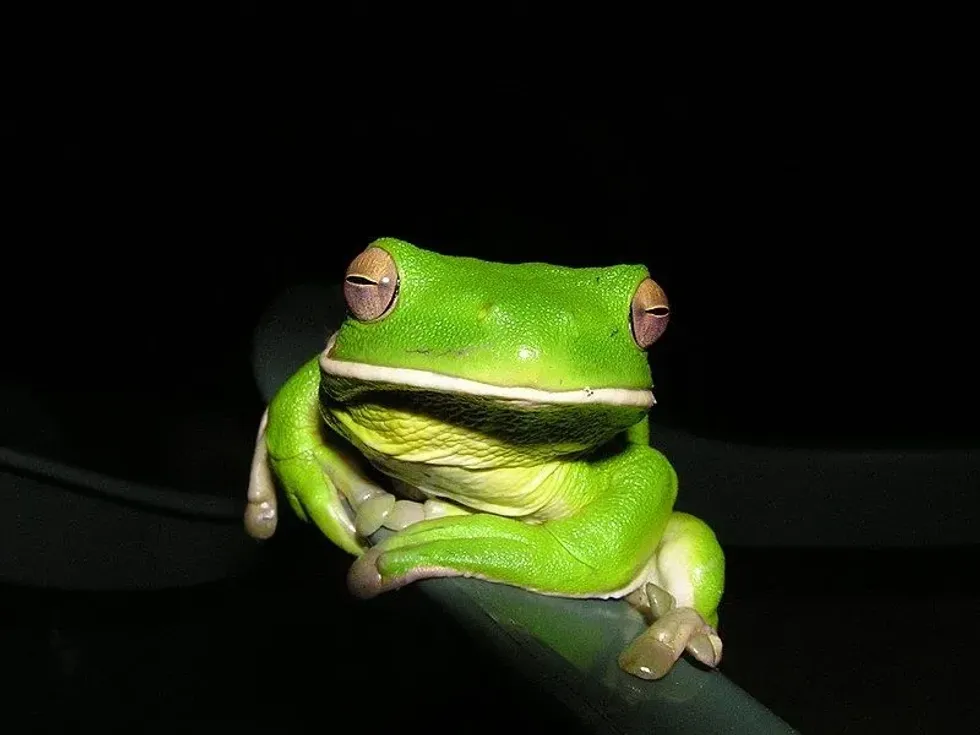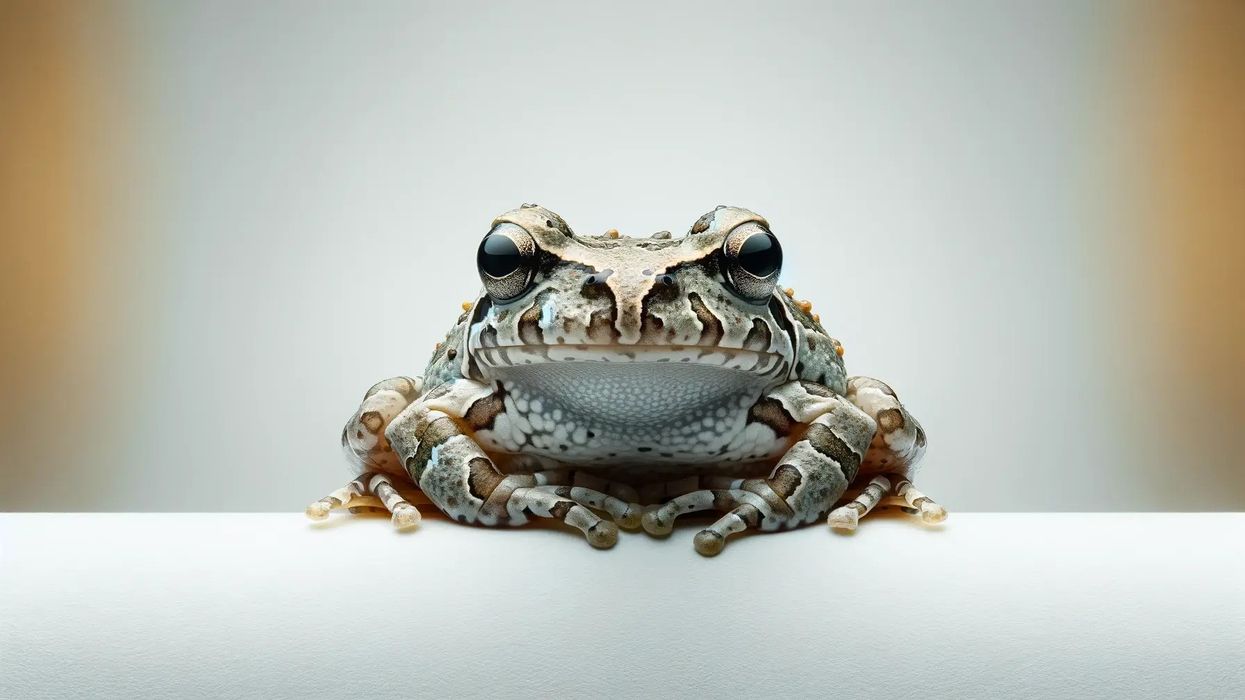The white-lipped tree frog is a large tree frog and is native to Australia. It is actually the largest tree frog in the world.
The other common names of this frog are the giant tree frog, New Guinea tree frog, and Australian tree frog.
These animals are mostly found in their preferred habitat range across rainforests and woodlands and in the coastal areas of Cape York Peninsula as well as in the regions of New Guinea and rainforest regions of Queensland in Australia. There are many special characteristics of these tree frogs that will make you curious.
Want to know about it? Here are some fun, engaging, and interesting facts on the white-lipped tree frog that is native to rainforest regions. Afterward, do have a look at our other animal fact files on glass frog and American bullfrog as well.
White-Lipped Tree Frog Interesting Facts
What type of animal is a white-lipped tree frog?
The white-lipped tree frog (Litoria infrafrenata) is the largest tree frog in the world. They are also known as giant tree frogs or Australian giant tree frogs. These tree frogs are agile climbers and are mostly found in tropical habitats. Their mating call is very different and can make a barking sound. White-lipped tree frogs are spread across Australia.
What class of animal does a white-lipped tree frog belong to?
The white-lipped tree frog is a large tree frog that belongs to the amphibian class. They come under the Litoria genus of the Hylidae family. Its scientific name is Litoria infrafrenata. The other common names of this frog include New Guinea treefrog, Australian giant treefrog, or Giant treefrog. They are widely spread across Australia.
How many white-lipped tree frogs are there in the world?
There is no accurate and rough estimate of the total number of white-lipped tree frogs in the world. They are a very common species in their range and have a stable population, and are concentrated in the northeast areas of Australia.
Where does a white-lipped tree frog live?
The habitat of the white-lipped green tree frog species is widely spread across Australia and is found in the coastal areas of the Cape York Peninsula, Townsville, and north-eastern Queensland, and around the Gulf of Carpentaria. They also inhabit the islands of Papua New Guinea, Indonesia, Timor Leste, and the Solomon Islands.
What is a white-lipped tree frog habitat?
White-lipped tree frogs can be seen in tropical habitats like rainforests, sclerophyll forests, and wet monsoon woodlands. Giant tree frog species also inhabit the coastal areas of Australia.
They can sometimes be spotted in human-dominated environments like farms, houses, or sheds. If you wish to have the white-lipped tree frog as a pet, then you must have a dedicated enclosure fitted with a UVB light.
Who do white-lipped tree frogs live with?
White-lipped tree frogs are social creatures and prefer to live in pairs or in groups. They are seen mostly together in groups comprising males and females both across their habitat.
How long does a white-lipped tree frog live?
White-lipped tree frogs have an average lifespan of 10 years in the wild. This may vary according to the surroundings as well as the diet available.
How do they reproduce?
The white-lipped tree frog breeding season occurs in summer and spring around still water bodies. Their mating calls sound like bark.
Males and females usually mate in still water bodies, and males have a salmon pink coloration on their arms and legs during the breeding season. Around 1000 dumbbell-shaped brown eggs are laid on the water surface near the breeding site by females, and the egg sac, which is a jelly-like texture, sinks to the bottom of the water.
Tadpoles are brown in color on the top and silver-yellow on the bottom. Frogs undergo metamorphosis and grow into adults within eight weeks, till that time, their diet is taken care of by the parents.
What is their conservation status?
White-lipped tree frogs are classified as the least concerned species by the IUCN Red List. Their population is stable, and hence be rest assured that they do not face any extinction threats.
White-Lipped Tree Frog Fun Facts
What do white-lipped tree frogs look like?
White-lipped tree frogs are the largest tree frog in the world. They are usually pure green or green-brown in color and have a white stripe covering the lower lip and extending to the forelimb, and the second white stripe is seen along the hind legs.
This is the reason that they are known as the only frog species with a white lip. These white stripes sometimes turn pink during the breeding season.
They have smooth and soft skin, and their feet are half webbed with a distinct tympanum. Vomerine teeth, used for holding food, are prominent in the front part of the mouth.
How cute are they?
White-lipped tree frogs are large tree frogs with pure green or green-brown color. These frogs are cute in appearance.
How do they communicate?
White-lipped tree frogs use sound to communicate with each other. During the rainy season, these frogs from Queensland make loud, barking calls. The mating calls of these Queensland tree frogs are exactly like a loud bark.
How big is a white-lipped tree frog?
White-lipped tree frogs are the largest tree frogs in the world and have a body length of 4.3- 5.5 in (10.9-13.9 cm). They are very large compared to the common frogs.
How fast can a white-lipped tree frog jump?
White-lipped tree frogs can jump around at an impressive speed of around 10 mph (16 kph).
How much does a white-lipped tree frog weigh?
White-lipped tree frogs are small in size and generally weigh around one to two oz (0.02-0.05 kg).
What are the male and female names of the species?
As a white-lipped tree frog is a frog, its species is l. infrafrenata. Both sexes are known as male white-lipped tree frogs and female white-lipped tree frogs.
What would you call a baby white-lipped tree frog?
A baby white-lipped tree frog is called a froglet or tadpole. There is a single cream stripe on one side of the body of the tadpoles.
What do they eat?
White-lipped tree frogs are carnivores (insectivores). Their main diet includes small insects and other arthropods.
The main predators of white-lipped tree frogs are golden tree snakes and pythons.
Are they poisonous?
White-lipped tree frogs are not poisonous and do not attack humans, but sometimes touching them can cause irritations. So avoid touching them unnecessarily.
Would they make a good pet?
White-lipped tree frogs can be good pets and are common in the pet trade. Frogs are easy to take care of but need an enclosure with enough space as they can grow up to 5 in (12.7 cm) long. Holding frogs is not a good idea as these animals tend to be distressed when held by humans.
Did you know...
White-lipped tree frogs are accidentally sent to other places in the boxes of bananas.
White-lipped tree frogs make a meow-like sound when they are distressed. There is no definitive research that can establish if frogs recognize their owners.
Do white tree frogs have teeth?
White-lipped tree frogs have vomerine teeth, which are small projections on the top of frog’s mouths. These types of teeth help them to hold their prey.
What frogs can live together?
Some species of tree frogs live together happily. This includes gray tree frogs (Hyla versicolor), green tree frogs (Hyla cinerea), red-eyed tree frogs, and barking tree frogs.
Here at Kidadl, we have carefully created lots of interesting family-friendly animal facts for everyone to discover! For more relatable content, check out these Pacman frog facts and crocodile skink facts pages.
You can even occupy yourself at home by coloring in one of our free printable White-Lipped Tree Frog coloring pages.









